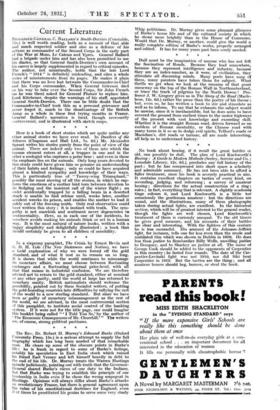* * * * No book about boxing, if it
recall the great battles of old, can possibly be dull. The plan of Lord Knebworth's Boxing : A Guide to Modern Methods (Seeley, Service and Co. ;
Lonsdale Library, 12s. precludes any full history of the past : but he has compressed into short space a scholarly and admirable summary. He has not been able to afford a fuller treatment, since his book is severely practical in aim. It contains excellent chapters on tactics of every kind, on seconding, judging, and refereeing ; a survey of amateur boxing ; directions for the actual construction of a ring ; rules ; in fact, everything that is relevant. A slightly acadeniiq tinge colours it, and Lord Knebworth is a little toff consciously the gentleman amateur : but the directions are sound, and the illustrations, many of them photographs taken during actual fights, are excellent. In the historical section, which will be of greatest interest to the general reader, though the fights are well chosen, Lord Knebworth't treatment of them is curiously unequal. To the old timers he gives good measure, and his accounts of their battles are clear and interesting. With the fighters of this century he is less successful. His account of the Johnson-Jeffries fight, for instance, tells one far less even than the crude and mutilated film which was shown in Dublin in 1910. He does less than justice to Bombardier Billy Wells, unwilling justice to Dempsey, and to Sharkey no justice at all. The name of George Cook should be added to the opponents of Carpentier in this country ; he lasted four rounds. The date of the Car- pentier-Levinski fight was not 1910, nor did Siki beat Carpentier in 1912. But the tactics are the thing • and all amateur boxers should beg, borrow, or steal the book.














































 Previous page
Previous page